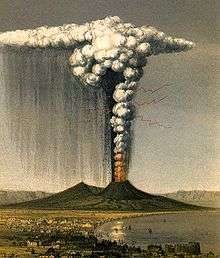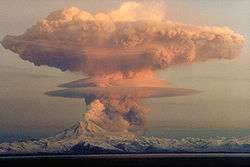Plinian eruption
Plinian eruptions or Vesuvian eruptions are volcanic eruptions marked by their similarity to the eruption of Mount Vesuvius in 79 AD, which destroyed the ancient Roman cities of Herculaneum and Pompeii. The eruption was described in a letter written by Pliny the Younger, after the death of his uncle Pliny the Elder.


Plinian/Vesuvian eruptions are marked by columns of volcanic debris and hot gases ejected high into the stratosphere, the second layer of Earth's atmosphere. The key characteristics are ejection of large amount of pumice and very powerful continuous gas-driven eruptions. According to the Volcanic Explosivity Index, Plinian eruptions have a VEI of 4, 5 or 6, sub-Plinian 3 or 4, and ultra-Plinian 6, 7 or 8.
Short eruptions can end in less than a day, but longer events can continue for several days or months. The longer eruptions begin with production of clouds of volcanic ash, sometimes with pyroclastic surges. The amount of magma erupted can be so large that it depletes the magma chamber below, causing the top of the volcano to collapse, resulting in a caldera. Fine ash and pulverized pumice can deposit over large areas. Plinian eruptions are often accompanied by loud noises, such as those generated by the 1883 eruption of Krakatoa. The sudden discharge of electrical charges accumulated in the air around the ascending column of volcanic ashes also often causes lightning strikes as depicted by the English geologist George Julius Poulett Scrope in his painting of 1822.
The lava is usually dacitic or rhyolitic, rich in silica. Basaltic, low-silica lavas are unusual for Plinian eruptions; the most recent basaltic example is the 1886 eruption of Mount Tarawera on New Zealand's North Island.[1]
Pliny's description


Pliny described his uncle's involvement from the first observation of the eruption:[2]
On August 24th, about one in the afternoon, my mother desired him to observe a cloud which appeared of a very unusual size and shape. He had just taken a turn in the sun and, after bathing himself in cold water, and making a light luncheon, gone back to his books: he immediately arose and went out upon a rising ground from whence he might get a better sight of this very uncommon appearance. A cloud, from which mountain was uncertain, at this distance (but it was found afterwards to come from Mount Vesuvius), was ascending, the appearance of which I cannot give you a more exact description of than by likening it to that of a pine tree, for it shot up to a great height in the form of a very tall trunk, which spread itself out at the top into a sort of branches; occasioned, I imagine, either by a sudden gust of air that impelled it, the force of which decreased as it advanced upwards, or the cloud itself being pressed back again by its own weight, expanded in the manner I have mentioned; it appeared sometimes bright and sometimes dark and spotted, according as it was either more or less impregnated with earth and cinders. This phenomenon seemed to a man of such learning and research as my uncle extraordinary and worth further looking into.
— Sixth Book of Letters, Letter 16, translation by William Melmoth
Pliny the Elder set out to rescue the victims from their perilous position on the shore of the Bay of Naples, and launched his galleys, crossing the bay to Stabiae (near the modern town of Castellammare di Stabia). Pliny the Younger provided an account of his death, and suggested that he collapsed and died through inhaling poisonous gases emitted from the volcano. His body was found interred under the ashes of the eruption with no apparent injuries on 26 August, after the plume had dispersed, confirming asphyxiation or poisoning.
Examples
- The Long Valley Caldera eruption in Eastern California, United States, which happened over 760,000 years ago.
- The 4860 BCE eruption forming Crater Lake in Oregon, United States.
- The 1645 BCE eruption of Thera in the south Aegean Sea, Greece.
- The 400s BCE eruption of the Bridge River Vent in British Columbia, Canada.
- The 79 CE eruption of Mount Vesuvius in Pompeii, Italy. It was the prototypical Plinian eruption.
- The 180 CE Lake Taupo eruption in New Zealand.
- The 946 eruption of Paektu Mountain in China / North Korea
- The 1257 eruption of Mount Samalas in Lombok, Indonesia
- The 1600 eruption of Huaynaputina in Peru.
- The 1667 and 1739 eruptions of Mount Tarumae in Hokkaido, Japan.[3]
- The 1707 eruption of Mount Fuji in Japan.
- The 1815 eruption of Mount Tambora in the island of Sumbawa, Indonesia.
- The 1883 eruption of Krakatoa in Sunda Strait, Indonesia.
- The 1886 eruption of Mount Tarawera in New Zealand.
- The 1980 eruption of Mount St. Helens in Washington in the western United States.
- The 1982 eruption of El Chichón in Chiapanecan Volcanic Arc, Chiapas, Mexico.
- The 1991 eruption of Mount Pinatubo in Zambales, Central Luzon, Philippines.
- The June 2009 eruption of Sarychev Peak in Russia.
Ultra-Plinian
According to the Volcanic Explosivity Index, a VEI of 6 to 8 is classified as "ultra-Plinian". Eruptions of this type are defined by ash plumes over 25 km (16 mi) high and a volume of erupted material 10 km3 (2 cu mi) to 1,000 km3 (200 cu mi) in size. Eruptions in the ultra-Plinian category include the Lava Creek eruption of the Yellowstone Caldera (c. 640,000 years ago, VEI 8), Lake Toba (c. 74,000 years ago, VEI 8), Tambora (1815, VEI 7), Krakatoa (1883, VEI 6), Akahoya eruption of Kikai Caldera, Japan and the 1991 Mount Pinatubo eruption in the Philippines (VEI 6).[4][5]
See also
- Peléan eruption, related to the explosive eruptions of the Mount Pelée
- Types of volcanic eruptions
- List of largest volcanic eruptions
References
- "Okataina Volcanic Centre/ Mt Tarawera Volcano". GNS Science. Retrieved 15 January 2020.
- Pliny's Letters. pp. 473–481.
- Enlightenment activities for improvement on disasters.
From 23–27 January 2006 Tarumae volcano [eruption], Japan, 4 cities near volcanoes.
- "How Volcanoes Work: Variability of Eruptions". San Diego State University. Retrieved 4 August 2010.
- Maeno F, Taniguchi H. (2005). "Eruptive History of Satsuma Iwo-jima Island, Kikai Caldera, after a 6.5ka caldera-forming eruption". Bulletin of the Volcanological Society of Japan. 50(2):71–85. ISSN 0453-4360.